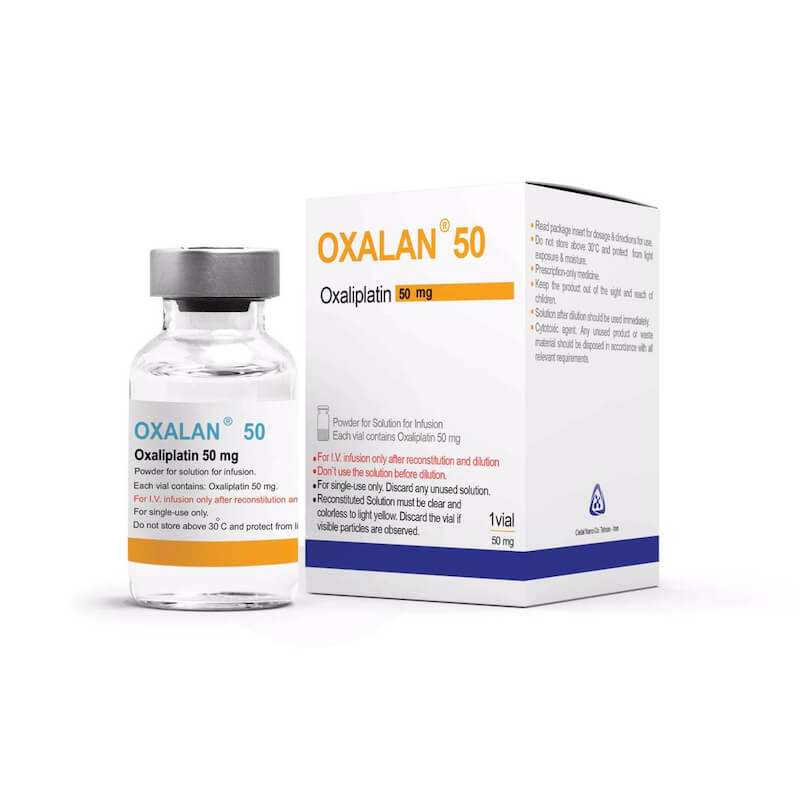– Hypersensitivity, anaphylactic reactions, and/or allergic reactions are reported with the use of OXALAN®. These can occur within minutes of OXALAN® administration, and can include rash, urticaria, erythema, pruritus, laryngospasm and, rarely, bronchospasm and hypotension. Allergic reactions can occur during any cycle. Patients with a history of allergic reaction to platinum compounds should be monitored for allergic symptoms. In case of an anaphylactic-like reaction to OXALAN®, the infusion should be immediately discontinued and appropriate symptomatic treatment initiated. These reactions are usually managed with epinephrine, corticosteroid, and antihistamine therapy. OXALAN® rechallenge is contraindicated.
– OXALAN® is associated with two types of neuropathies:
- a) An acute, reversible, primarily peripheral, sensory neuropathy that is of early onset, occurring within hours or one to two days of dosing, that resolves within 14 days, and that frequently recurs with further dosing. The symptoms may be precipitated or exacerbated by exposure to cold temperature or cold objects and they usually present as transient paresthesia, dysesthesia and hypoesthesia in the hands, feet, perioral area, or throat. Jaw spasm, abnormal tongue sensation, dysarthria, eye pain, and a feeling of chest pressure have also been observed. Ice (mucositis prophylaxis) should be avoided during the infusion of OXALAN® because cold temperature can exacerbate acute neurological symptoms.
- b) A persistent (>14 days), primarily peripheral, sensory neuropathy that is usually characterized by paresthesias, dysesthesias, hypoesthesias, but may also include deficits in proprioception that can interfere with daily activities (e.g., writing, buttoning, swallowing, and difficulty walking from impaired proprioception). Persistent neuropathy can occur without any prior acute neuropathy event. These symptoms may improve in some patients upon discontinuation of OXALAN®.
– Reversible Posterior Leukoencephalopathy Syndrome (RPLS, also known as PRES, Posterior Reversible Encephalopathy Syndrome) has been observed. Signs and symptoms of RPLS could be headache, altered mental functioning, seizures, abnormal vision from blurriness to blindness, associated or not with hypertension. Diagnosis of RPLS is based upon confirmation by brain imaging.
– OXALAN® has been associated with pulmonary fibrosis, which may be fatal. In case of unexplained respiratory symptoms such as non-productive cough, dyspnea, crackles, or radiological pulmonary infiltrates, OXALAN® should be discontinued until further pulmonary investigation excludes interstitial lung disease or pulmonary fibrosis.
– Hepatotoxicity with the use of OXALAN® plus 5-FU/LV has been occurred. Hepatic vascular disorders should be considered, and if appropriate, should be investigated in cases of abnormal liver function test results or portal hypertension, which cannot be explained by liver metastases. There is evidence that OXALAN® causes liver sinusoidal obstruction syndrome, also known as veno-occlusive disease of the liver, which on liver biopsy is manifested as peliosis, nodular regenerative hyperplasia, and perisinusoidal fibrosis.
– OXALAN® may lead to irreversible infertility. It is recommended that men treated with OXALAN® should not procreate during treatment and for up to 6 months after the end of treatment; they should also seek advice about sperm storage prior to treatment.
– Patients receiving OXALAN® plus 5-FU/leucovorin and requiring oral anticoagulants may require close monitoring.
– Cases of QT prolongation and Torsade de Pointes have been reported. QT prolongation may lead to an increased risk for ventricular arrhythmias including Torsade de Pointes, which can be fatal. Caution should be exercised in patients with a history or a predisposition for prolongation of QT, those who are taking medicinal products known to prolong QT interval, and those with electrolyte disturbances such as hypokalemia, hypocalcaemia, or hypomagnesaemia. In case of QT prolongation, oxaliplatin treatment should be discontinued.
– OXALAN® treatment resulting in an increased risk of dizziness, nausea and vomiting, and neurologic gait and balance disorders may have influence on the ability to drive and operate machinery.
– Gastrointestinal toxicity, which manifests as nausea and vomiting, warrants prophylactic and/or therapeutic antiemetic therapy. Dehydration, ileus, intestinal obstruction, hypokalemia, metabolic acidosis, and even renal disorders, may be associated with severe diarrhea/emesis, particularly when combining OXALAN® with 5-FU. In rare cases, colitis, including Clostridium difficile diarrhea, have occurred. Patients must be adequately informed of the risk of diarrhea/emesis after OXALAN®/5-FU administration in order to contact urgently their treating physician for appropriate management. OXALAN® treatment can cause intestinal ischaemia, duodenal ulcer (DU) and potential complications, such as duodenal ulcer haemorrhage and perforation, which can be fatal. In case of duodenal ulcer and intestinal ischaemia, OXALAN® treatment should be discontinued and appropriate measures taken.
– Patients must be adequately informed of the risk of neutropenia after OXALAN®/5-FU administration in order to contact urgently their treating physician for appropriate management. Cases of febrile neutropenia (including fatal cases) have been reported. If neutropenia or febrile neutropenia (fever of unknown origin without clinically or microbiologically documented infection with an absolute neutrophil count < 1.0 × 109/L, a single temperature of > 38.3°C or a sustained temperature of > 38°C for more than one hour) occurs, OXALAN® must be discontinued until improvement or resolution, and the dose of OXALAN® should be reduced at subsequent cycles, in addition to any 5-FU dose reductions required.
– Hemolytic Uremic Syndrome (HUS) is a life-threatening side effect. OXALAN® should be discontinued at the first signs of any evidence of microangiopathic hemolytic anemia, such as rapidly falling hemoglobin with concomitant thrombocytopenia, elevation of serum bilirubin, serum creatinine, blood urea nitrogen, or lactate dehydrogenase (LDH). Renal failure may not be reversible with discontinuation of therapy and dialysis may be required.
– Sepsis, neutropenic sepsis and septic shock have been reported in patients treated with oxaliplatin, including fatal outcomes. If any of these events occurs, OXALAN® should be discontinued.
– Rhabdomyolysis has been reported in patients treated with OXALAN®, including fatal outcomes. In case of muscle pain and swelling, in combination with weakness, fever or darkened urine, OXALAN® treatment should be discontinued. If rhabdomyolysis is confirmed, appropriate measures should be taken. Caution is recommended if medicinal products associated with rhabdomyolysis are administered concomitantly with OXALAN®.
– In case of OXALAN® extravasation, the infusion must be stopped immediately and usual local symptomatic treatment initiated.


